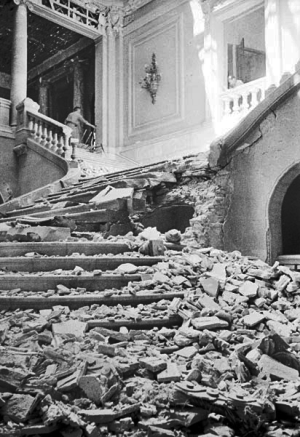Air-raid shelter Valencia City Council
NOTICE: Due to the closures of Arzobispo Mayoral Street for the pyrotechnic
displays (mascletás) during the Fallas celebrations, from the 1st to the
19th of March, the visiting hours for the Municipal Exhibition Hall and
the Civil War Air Raid Shelter will be from 10:00 to 12:00 and from
15:30 to 19:00. We apologise for any inconvenience caused.
From January 1937, with the capital of the Republic already settled in the city, until March 1939, Valencia and the seaside towns suffered incessant bombardments that sowed death and destruction. Tons of explosives were dropped on a defenseless and overwhelmed population that suddenly found war on their doorstep. Night and day, often without the warning of the sirens whose sound was enough to cause panic, planes and ships from the rebel side dropped bombs and projectiles on the city.
In the face of that iron storm it became necessary to organize the protection of the population, the Anti-Aircraft Defense Board, from January 1937 Passive Defense Board, took care of it. For this purpose, rules of conduct were issued and the construction of dozens of underground shelters began. Shelters in schools, shelters in factories, shelters in the headquarters of the Government of the Republic, public shelters in different neighborhoods... And, from 1938, when the intensity and frequency of bombings increased notoriously, so did small private shelters. More than 300 were built in the city and, although of many of them only the list or plans remain in the Municipal Historical Archive, others fortunately remained as witnesses of those hard years that should not be forgotten. One of these refuges is the one preserved in the interior courtyard of the City Council building and that can be visited since 2017.
It is a school-type shelter, built in 1938 (between January and July of that year) by the architect José Luis Testor and which had a capacity to house 700 children from the school located on one side of the Town Hall building. It consists of two symmetrical entrances by means of stairs and five parallel elongated naves, covered with a low vault made of concrete, and connected to each other by semicircular arches.
 The two end aisles are longer. In one of them was located the engine room with the electric air extractor, which was connected to a network of channels below the floor and inside the walls, which managed to maintain adequate ventilation within the shelter; This extractor had a crank to operate it manually in case the power supply failed. At the other end of the shelter were the toilets, whose drain went to a blind well.
The two end aisles are longer. In one of them was located the engine room with the electric air extractor, which was connected to a network of channels below the floor and inside the walls, which managed to maintain adequate ventilation within the shelter; This extractor had a crank to operate it manually in case the power supply failed. At the other end of the shelter were the toilets, whose drain went to a blind well.
All the warehouses had brick benches, where schoolchildren could sit while they waited for the danger to pass (now disappeared by later renovations). The shelter had electricity distributed through copper tubes that contained the cable and that gave light to the faint bulbs that hung directly from the ceiling.
The shelter was rehabilitated in 2016 recovering the appearance it should have originally. On the other hand, the museum project was prepared as a low-intensity intervention, in order to enhance the building itself. Thus, information panels have been placed at the headboards of the naves, and in the first room a screen has been installed to project four audiovisuals that collect images of bombings of cities by Italian troops and various testimonies of residents of Valencia who experienced them first-hand.
Likewise, the access corridor to the shelter has been adapted as an introduction, with information on the existing air-raid shelters in Valencia. We can see here a map of the city with the location of known shelters, as well as the impacts of bombs dropped by national aviation. There is also information on the different types of air-raid shelters, as well as their use after the end of the war. Finally, a section is dedicated to the effects of the bombing suffered by the City Hall building on May 28, 1937.
Access to the shelter through the Municipal Exhibition Hall, entrance through Archbishop Mayoral street corner with Journalist Azzati street.
Dades bàsiques
- Tuesday to Saturday: 10-14 hr. and from 3 p.m. to 7 p.m.
- Sunday and public holidays: from 10 am to 2 pm.
- Monday: CLOSED.
- The Refuge will be CLOSED on January 1st and 6th, May 1st and December 25th.
- Rooms must be left 10-20 minutes before closing time.
NOTICE: Due to the closures of Arzobispo Mayoral Street for the pyrotechnic
displays (mascletás) during the Fallas celebrations, from the 1st to the
19th of March, the visiting hours for the Municipal Exhibition Hall and
the Civil War Air Raid Shelter will be from 10:00 to 12:00 and from
15:30 to 19:00. We apologise for any inconvenience caused.
The visit is free. All visitors must be properly documented (ID card, passport, etc.).
Valencia City Council.
Access is through the Town Hall Exhibition Hall, Calle Arquebisbe Mayoral, núm. 1.